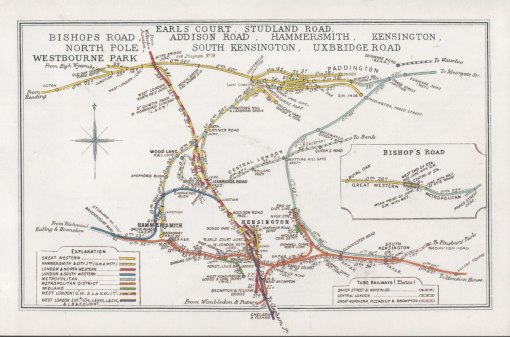The origins of the London & North Western Railway’s involvement on the Circle are somewhat complex, extremely fascinating but ultimately beyond the scope of the history of Basilica Fields. However, a précis is desirable in order to explain the presence of Webb’s tanks in the East End!
The general public were slow to embrace train travel across town, largely preferring to walk, until the introduction of cheap workmen’s fares in the mid-1860s on the Metropolitan and Chatham lines popularised suburban rail journeys among the working classes. By the time of the Cheap Trains Act of 1883 it had become well established, with the horse-drawn tram demoted to second best except in the west and north-west tram-less districts where the horse drawn omnibus still held sway on the roads. Although the tram companies also offered cheap workmen’s return tickets, the ‘bus companies made little, and often no attempt to provide services before half past eight in the morning, and it was in this scenario, in the decades before direct electrified underground services across town, that steam-hauled ‘long way round’ suburban services flourished in a network of meandering connecting links and radial routes, some of which had lain dormant since the 1830s.
One such route was the West London Railway (WLR); initially promoted as the Birmingham, Bristol & Thames Junction Railway, it was authorised to run between Willisden Junction and Kensington Canal in 1836, but floundered as construction was beset by engineering problems. In 1840 it took up the title of the WLR, and for three years half a mile of the line was leased to the promoters of the atmospheric railway, and trials were undertaken to demonstrate the potential of that system.
In May 1844 the WLR was finally opened utilising conventional steam power, but suffered from a lack of patronage, and six months later services were withdrawn and the line closed. The following year the line was jointly leased by the Great Western and London & Birmingham Railways (the latter would become the dominant constituent of the London & North Western in 1846) and for eighteen years passenger services remained dormant while the line used for mineral traffic only.
Iin 1859 an Act granted the Great Western, London & North Western, London Brighton & South Coast and the London & South Western Railways power to double the line and construct an extension to cross the Thames to connect with the LB&SC and LSWR south of the river at a point close to Clapham Junction. The International Exhibition at Kensington in 1862 proved to be a good reason to introduce services from Harrow, and the following March full services over the line and the extension began in earnest.
In 1869 the Met & District (MDR) began construction of a spur off its line through Earls Court to join with the West London Railway at Kensington, and passenger services running from Broad Street (North London Railway) to Mansion House (MDR) and promoted by the LNWR as the Outer Circle, commenced in February 1872. With the opening of the Extended Circle and Extended Widened Lines in the late 1880s, the LNWR introduced a limited service of one train an hour beyond Mansion House to the Extended Circle via the junction at Mark Lane. This service initially terminated at Basilica Fields, but by 1892 was extended to Bishopsgate (Liverpool Street), the journey effectively, if not physically, completing a full circle. When the Outer Circle trains were electrified in December 1905, the LNWR negotiated to maintain the steam hauled service to Bishopsgate via Basilica Fields for three years, until the end of December 1908.

October 25, 2010 at 10:03 pm
Being an “oldie”, and prone to reminisce whenever the opportunity occurs, this reminds me of when I worked in The City (and I mean geographically, rather than by trade) in the 1960s and ’70s. The practice of businesses putting railway “carters” call-request cards in their windows was still the norm. Moreover, I distinctly noted that the L&NWR was prominent, together with MR and GER.
Of course, they all had goods yards in the vicinity of the The City’s eastern edge, but what puzzled me was why the cards from the pre-grouping companies still existed. Was it just a question of habit, or was card prior to 1923 more robust? They had obviously survived the Blitz in an area which was hit as hard as any – and the proof was in the many “bomb-sites” still existing in that period. It may be that some cards were not just pre-grouping, but pre-1st-WW.
This was when I realised that the smaller lines running to difficult timetables on restricted tracks were much more interesting than “big green engines” with fancy names. What a pity there was no obvious link from the fascinating North London Railway with their unique(?) 4-4-0Ts to Basilica Fields.
October 26, 2010 at 9:30 pm
The use of pre-Group call request cards in the 60s and 70s is astonishing, and is definitely something worth following up later.
As for the NLR, well the eastern end of the extended circle curved right past Bow…